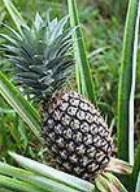|
Cultivation Practices-Kew

Kew is a late-maturing variety and is valued particularly for it's canning quality.
Fruit weighs 2-3 kg, and is oblong in shape, slightly tapering towards the crown.
Eyes are broad and shallow making fruits more suitable for canning. The fruit
is yellow when fully ripe and flesh is light yellow, almost fibreless, and very
juicy with 0.6-1.2 % acid, and its TSS content varies from 12-16° Brix.
The package of recommendations for its cultivation is detailed below.
Preparation of the land
Prepare the land for planting by ploughing or digging followed by leveling.
Depending on the nature of land, prepare trenches of convenient length and about
90 cm width and 15-30 cm depth. The trenches are to be aligned at a distance
of 1.65 m from centre to centre.
Selection and treatment of suckers
Select healthy suckers of uniform size weighing 0.5-1 kg. Keep suckers in
open space under shade in a single layer for about 7 days for drying. Strip
off a few lower old dried leaves. Allow the suckers to dry and cure for another
7 days. Dip the cured suckers in 1% Bordeaux mixture at the time of planting.
Planting
Rake the soil and plant the suckers in double rows at spacing of 70 cm between rows
and 30 cm between plants. Limit the depth of planting to 7.5 to 10 cm.
Adopt triangular method of planting in each trench so that the plants in two adjacent
rows are not opposite to each other (plant population 40,400/ha).
Manuring
Apply compost/ cattle manure at 25 t/ha as basal dressing. Apply fertilizers at
the following dosage:
|
Dose
|
N:P2O5:K2O
|
|
Per plant per year (g)
|
8:4:8
|
|
Per hectare per year (kg)
|
320:160:320
|
Apply full dose of P2O5 at the time of planting. Nitrogen
and K2O may be applied in four splits, during May-June (at planting),
August-September, November and May-June (2nd year). In places where rains are scanty
during November, N and K2O may be applied in three equal splits - two
doses in 1st year (May-June and August-September) and the third in May-June of the
second year. After application of fertilizers, cover with soil by scraping the sides
of trenches.
Irrigation
During summer months, pineapple should be irrigated wherever possible at 0.6 IW/CPE
ratio (5 cm depth of water). It requires five or six irrigations during dry
months at an interval of 22 days. Mulching the crop with dry leaves at 6 t/ha
will help to conserve moisture.
Weed control
For effective and economic weed control, use weedicides. Pre-emergent spray
with diuron 3 kg or bromacil 2.5 kg in 600 litres of water per hectare completely
controls all types of weeds in pineapple plantation. If there is subsequent
growth of weeds, herbicide application may be repeated at half the above dose.
Spraying should be done when there is adequate moisture in the soil. Avoid
periods of heavy rainfall for spraying.
Induction of flowering
During summer months and festival seasons, there is heavy demand for fruit and the
prices increases. Hence many farmers schedule the planting, growth regulator
application and harvest to synchronize with the season of demand and high price.
For inducing uniform flowering at the desired period, apply 25 ppm ethephon (2-chloro
ethyl phosphonic acid) in aqueous solution containing 2% urea and 0.04% calcium
carbonate as follows:
The mixture (50 ml/plant) is to be applied pouring into the heart of 10-12 months
old plants (39-42 leaf stage) during dry weather. For treating 1000 plants,
50 litres of the solution would be required. (The ingredients for preparing
50 litres of the aqueous solution are ethephon 1.25 ml, urea 1 kg and calcium carbonate
20 g, made up to 50 litres with water. The dosage has to be fixed depending
on the availability of commercial formulation and the active ingredient contents).
Fruits will be ready for harvest by 5 ¼- 5 ¾ months
after the application of growth regulator.
Top
|